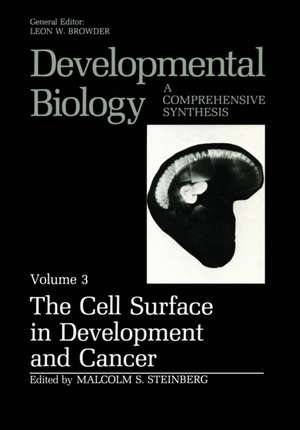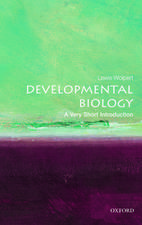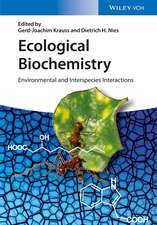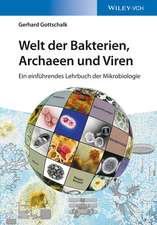The Cell Surface in Development and Cancer: Developmental Biology, cartea 3
Editat de Malcolm S. Steinbergen Limba Engleză Paperback – 12 aug 2013
Preț: 398.53 lei
Nou
Puncte Express: 598
Preț estimativ în valută:
76.26€ • 79.82$ • 63.47£
76.26€ • 79.82$ • 63.47£
Carte tipărită la comandă
Livrare economică 31 martie-14 aprilie
Preluare comenzi: 021 569.72.76
Specificații
ISBN-13: 9781468450521
ISBN-10: 1468450522
Pagini: 384
Ilustrații: XV, 364 p.
Dimensiuni: 178 x 254 x 20 mm
Greutate: 0.66 kg
Ediția:Softcover reprint of the original 1st ed. 1986
Editura: Springer Us
Colecția Springer
Seria Developmental Biology
Locul publicării:New York, NY, United States
ISBN-10: 1468450522
Pagini: 384
Ilustrații: XV, 364 p.
Dimensiuni: 178 x 254 x 20 mm
Greutate: 0.66 kg
Ediția:Softcover reprint of the original 1st ed. 1986
Editura: Springer Us
Colecția Springer
Seria Developmental Biology
Locul publicării:New York, NY, United States
Public țintă
ResearchCuprins
l • Cell Surfaces in the Control of Growth and Morphogenesis.- 1. Introduction.- 2. Cell Surfaces in the Control of Cell Proliferation.- 3. Cell Surfaces and the Control of Multicellular Assembly.- 4. Adhesive Specification of Pronephric Duct Segregation and Migration.- References.- 2 • The Cell Surface and Cancer Metastasis.- 1. Introduction.- 2. Tumor Models.- 3. Tumor Cell Heterogeneity and Correlation of Cell Surface Changes with Metastatic Behavior.- 4. Obligatory and Nonobligatory Phenotypes: Demonstrating Causality between Phenotypic Change and Metastatic Behavior.- 5. Experimental Manipulation of the Metastatic Properties of Tumor Cells: Fulfilling Koch’s Postulates at the Molecular Level.- References.- 3 • Shedding of Plasma Membrane Fragments: Neoplastic and Developmental Importance.- 1. Introduction.- 2. Historical Background.- 3. Membrane Structure.- 4. Characteristics of Shedding.- 5. Mechanisms of Shedding.- 6. Nonimmunological Consequences of Shedding.- 7. Immunological Consequences of Shedding.- 8. Embryological and Developmental Importance of Shedding.- 9. Summary.- References.- 4 • Regulation of Glycoprotein Synthesis during Development of the Sea Urchin Embryo.- 1. Introduction.- 2. The Effect of Tunicamycin on Development.- 3. Requirement of Dolichol Synthesis for Gastrulation.- 4. Metabolic Interconversion of Dolichol and Dolichylphosphate during Development.- 5. Regulation of the Synthesis of Glycosylatable Proteins.- 6. The Role of Glycoproteins in the Gastrulation Process.- 7. Conclusions.- References.- 5 • The Morphological Oncogenic Signature: Reorganization of Epithelial Cytoarchitecture and Metabolic Regulation Transformation.- 1. Introduction.- 2. Promoter-Induced Alterations of Epithelial Morphology: Scanning ElectronMicroscopy.- 3. Cytoskeletal Reorganization in Response to TPA.- 4. Morphological Alterations Retained in the NM-IF Scaffold.- 5. Immunofluorescent Localization of Cytokeratin and Desmosomal Proteins in NM-IF Scaffolds after TPA.- 6. Protein Synthesis and Distribution after Exposure to TPA.- 7. Alteration of Protein Synthesis in Suspension Culture.- 8. Induction of Morphological Signature in Permanently Transformed MDCK Cells.- 9. Summary.- References.- 6 • Growth Control in Capillary Endothelium.- 1. Introduction.- 2. Methods for the Study of Angiogenesis.- 3. Events of Capillary Growth.- 4. The Role of Mast Cells and Heparin in Angiogenesis.- 5. Angiogenic Factors.- 6. Angiogenesis Inhibitors.- 7. Conclusions.- References.- 7 • The Growth Factor-Platelet-Transformation Connection.- 1. Introduction.- 2. Why Does Serum Stimulate the Growth of Cultured Animal Cells?.- 3. Platelet Derived Growth Factor.- 4. Epidermal Growth Factor in Platelets.- 5. Transforming Growth Factors.- 6. PDGF-like Molecules Produced by Transformed Cells.- 7. The Platelet as a Circulating Paracrine Cell—A Role for Transforming Growth Factors in Normal Animals.- References.- 8 • Intercellular Recognition and Adhesion in Desmosomes.- 1. Introduction.- 2. Cell Junctions and Intercellular Adhesion.- 3. The Adhaerens Junction.- 4. Molecular Architecture of the Desmosome.- 5. Desmosomes in Intercellular Recognition.- 6. The Hemidesmosome.- 7. Desmosomes and Hemidesmosomes in Morphogenetic Processes.- 8. Desmosomes and Cancer.- 9. Concluding Remarks: Future Problems.- References.- 9 • Dual Adhesive Recognition Systems in Chick Embryonic Cells.- 1. Introduction.- 2. Dual Systems of Embryonic Adhesion.- 3. Adhesive Specificity and Cellular “Recognition”.- 4. Conclusions.- References.- 10• Gap Junctions in Development.- 1. Introduction.- 2. Structure of Junctions.- 3. Study of Junctions in Embryonic Systems.- 4. Cell Communication in Embryonic Systems.- 5. Conclusions.- References.- 11 • Cell-Cell and Cell-Matrix Interactions in the Morphogenesis of Skeletal Muscle.- 1. Introduction to Skeletal Myogenesis.- 2. Experimental Analysis of Cell-Substratum Attachment in Muscle Cell Cultures.- 3. Effects of a Fibronectin-Containing Matrix on Muscle Morphogenesis.- 4. Effects of Fibronectin on Other Events in Myogenesis.- 5. Perspectives.- References.- 12 • Extracellular Matrix Involvement in Epithelial Branching Morphogenesis.- 1. Introduction.- 2. Collagen in Branching Morphogenesis of Embryonic Salivary Gland and Lung.- 3. Glycoconjugates in Branching Morphogenesis.- 4. Proteoglycans in Branching Morphogenesis.- 5. Tunicamycin Effects on Branching Morphogenesis.- 6. Anionic Sites in the Salivary Basal Lamina.- 7. Conclusions.- References.- 13 • Cell-Cell Interactions in the Development of Dictyostelium.- 1. Life Cycle.- 2. Aggregation.- 3. Chemotaxis.- 4. cAMP Signaling.- 5. Identification of the Cell Surface cAMP Receptor.- 6. Putative GTP-Binding Regulatory Protein in D. discoideum.- 7. Progress in Purification of Adenylate Cyclase and Receptor.- 8. Summary.- References.- 14 • Growth Cone Guidance and Cell Recognition in Insect Embryos.- 1. Introduction.- 2. The First Growth Cones in the Insect CNS.- 3. Selective Affinity for Nonneuronal and Neuronal Surfaces.- 4. Cell-Ablation Experiments.- 5. Conclusions.- References.- 15 • Guidance of Neural Crest Migration: Latex Beads as Probes of Surface-Substratum Interactions.- 1. Neural Crest Migratory Pathways.- 2. Microinjection Technique.- 3. Translocation of Embryonic Cells on the Ventral NeuralCrest Pathway.- 4. Latex Beads as Probes of the Neural Crest Ventral Pathway.- 5. Laser Ablation of the Avian Neural Crest.- 6. Summary.- References.- 16 • Cell Traction in Relationship to Morphogenesis and Malignancy.- 1. Introduction.- 2. Traction and Its Detection: Observations using Elastic Substrata.- 3. Silicone Rubber Substrata.- 4. Collagen Substrata and the Tractional Structuring Phenomenon.- 5. Reduced Tractional Strength and Its Relationship to Invasiveness.- References.
















